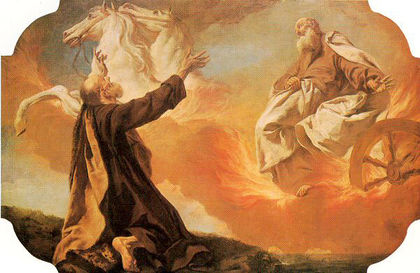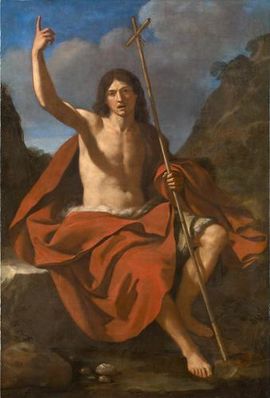John the Baptist/es: Difference between revisions
(Created page with "El maestro ascendido '''Juan el Bautista''' tuvo dos encarnaciones de las que hay constancia en la Biblia: el profeta del Antiguo Testamento '''Elías''' y Juan el Bautista de...") |
(Created page with "== Elías y Eliseo ==") |
||
| Line 4: | Line 4: | ||
El maestro ascendido '''Juan el Bautista''' tuvo dos encarnaciones de las que hay constancia en la Biblia: el profeta del Antiguo Testamento '''Elías''' y Juan el Bautista del Nuevo Testamento. El propio Jesús declaró que Juan el Bautista era Elías venido de nuevo.<ref></ref> | El maestro ascendido '''Juan el Bautista''' tuvo dos encarnaciones de las que hay constancia en la Biblia: el profeta del Antiguo Testamento '''Elías''' y Juan el Bautista del Nuevo Testamento. El propio Jesús declaró que Juan el Bautista era Elías venido de nuevo.<ref></ref> | ||
== | == Elías y Eliseo == | ||
The story of Elijah the Tishbite and his disciple Elisha (an earlier embodiment of [[Jesus]]) is recorded in the Book of Kings, where Elijah’s ascension is described in this way: “There appeared a chariot of fire, and horses of fire, and parted them both asunder; and Elijah went up by a whirlwind into heaven.”<ref>2 Kings 2:11.</ref> | The story of Elijah the Tishbite and his disciple Elisha (an earlier embodiment of [[Jesus]]) is recorded in the Book of Kings, where Elijah’s ascension is described in this way: “There appeared a chariot of fire, and horses of fire, and parted them both asunder; and Elijah went up by a whirlwind into heaven.”<ref>2 Kings 2:11.</ref> | ||
Revision as of 03:07, 3 March 2020

El maestro ascendido Juan el Bautista tuvo dos encarnaciones de las que hay constancia en la Biblia: el profeta del Antiguo Testamento Elías y Juan el Bautista del Nuevo Testamento. El propio Jesús declaró que Juan el Bautista era Elías venido de nuevo.Cite error: Invalid <ref> tag; refs with no name must have content
Elías y Eliseo
The story of Elijah the Tishbite and his disciple Elisha (an earlier embodiment of Jesus) is recorded in the Book of Kings, where Elijah’s ascension is described in this way: “There appeared a chariot of fire, and horses of fire, and parted them both asunder; and Elijah went up by a whirlwind into heaven.”[1]
After Elisha witnessed his teacher’s ascension, he took up “the mantle of Elijah that fell from him” and he smote the waters of Jordan. When the waters parted and Elisha went over, the sons of the prophets saw that the spirit of Elijah rested on Elisha. From that time on, Elisha performed many miracles, feats of alchemy that were prophetic of the triumph of his Spirit over matter during his final embodiment as Jesus. The accounts of Elisha healing the waters, multiplying the widow’s oil, opening the womb of the Shunammite and later the raising of her son from the dead, the multiplying of the loaves of barley and the curing of Naaman of leprosy are recorded in the second book of Kings together with other demonstrations of the Law by this “Man of God.”

John the Baptist
After his ascension, Elijah received the almost unique dispensation that enabled him to reembody; and so he came again as John the Baptist to “prepare the way of the Lord.” He willingly took on a flesh form and allowed himself to be sacrificed at the hand of Herod, in order to assist his disciple to fulfill his mission.
The relationship of Jesus and John the Baptist is a story of great devotion, love and respect—beautiful to behold and seldom equaled. It is the story of the guru-chela, master-disciple relationship. Being the great and humble teacher that he was, John said of Jesus, “He must increase, but I must decrease”[2]; for he bore in his heart the great God-desire that Jesus should exceed him in attainment and in service. He wanted to remain in the background, to see the glory—the full mantle of his ascended consciousness—upon Jesus. After his lifetime as John the Baptist, he returned to the ascended state.
His service today
The ascended master John the Baptist says:
There must be a meeting ground for heaven and earth, and that is the place of the heart. Your heart is the receiver of God, of Christed ones; and the womb of the Divine Mother is the recipient of the seed of Alpha for the birth of the Divine Manchild. Therefore, as Christed ones, welcome the King of kings and Lord of lords into your heart! As flames of the Divine Mother, cherish the incarnation of the Christ!
It is the materialization of the God flame that we pursue to make earth a haven of light that all mankind might know the kingdom of God within and without, the conformity of sacred law.[3]
Sources
Mark L. Prophet and Elizabeth Clare Prophet, The Masters and Their Retreats, s.v. “Elijah (John the Baptist).”
